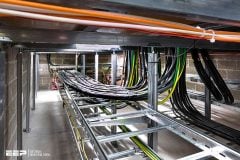AC Power Fluctuations
In addition to lightning, there are a number of other disturbances that can come in on the AC power lines and damage equipment. Some surge protectors can reduce or eliminate damage from some of these perturbations. There is considerable confusion about the overlap between damage from AC power disturbances and from lightning.

Five different anomalies in AC power can damage equipment commonly found in homes. They are as follows //
- Open neutral events
- Catastrophic overvoltages
- Sustained AC overvoltages
- AC undervoltages / brownouts
- Utility switching transients
1. Open neutral events
It is not widely appreciated that “open-neutral events” are a very common cause of damage to customer equipment, at least in some areas.
Open-neutral problems arise when the neutral wire (see Figure 1) between the center tap of the distribution transformer and the neutral at the service equipment becomes loose, broken, or disconnected, or where the neutral-ground bond inside the house is defective.


At the transformer, the 240 V full-phase output is evenly divided into two 120 V phase voltages, with the neutral wire being common for both phases. If the neutral connection is disconnected or broken, the 240 V full-phase voltage at the house will no longer be divided into two equal 120 V phases.
The division will be determined mainly by the relative load on the two phases, 4 and the phase-neutral voltages can easily be as different as 200 V on one phase, and 40 V on the other. The excess voltage on one phase can easily damage 120 V equipment.
However, a combination of entrance protectors and some point-of-use (plug-in) surge protectors can protect or reduce damage to equipment plugged into them.


The load current doesn’t flow through the entrance protector, so that if the fuses open, the power continues to the load. For plug-in protectors (B, C), the load current flows through the protector.
“Disconnecting” protectors (B) disconnect the load if a severe surge or overvoltage occurs. However, some plug-in protectors (C) disconnect only the surge protection components, allowing the surge to flow into the load.
In all figures, this symbol represents a surge limiting component (gas tube, MOV, transorb, sidactor) that becomes conductive when the voltage across it exceeds a certain level.
2. Catastrophic overvoltages
Rare “catastrophic”overvoltages can result from accidental contact between high voltage lines and low voltage AC distribution lines, due to icing, traffic accidents, falling trees, etc. In such situations, voltages up to thousands of volts can be brought into houses.
3. Sustained AC overvoltages
Sustained overvoltages (typically, over 135 V on 120 V service) can result from malfunction of utility regulators or damaged distribution transformers.
AC building entrance protectors do not provide useful protection against these events. Electronically controlled point-of-use (plug-in) surge protectors disconnect for AC voltages outside a specified range, and offer useful protection to equipment plugged into them.
4. AC undervoltages / brownouts
AC undervoltages (typically, below ~100 V) may result from overloaded transformers or utility or building wiring, or malfunctioning regulators. Undervoltages can lead to equipment damage because motor-driven appliances and some electronic power supplies draw higher current at low voltage and will overheat.
A few of the point-of-use (plug-in) surge protectors are electronically controlled, and will disconnect at low voltage and should protect equipment plugged into them.
5. Utility switching transients
Utility switching transients that come into homes are generally of relatively low voltage and energy.
Switching transients large enough to damage customer equipment will normally be adequately controlled by either building entrance protectors or plug-in protectors.


In areas where the environment is very rugged and utility lines are long and subject to frequent damage, the protectors can greatly decrease damage to residential equipment, for a modest expense. So even if there is little lightning risk, it can be worthwhile to install these protectors.
Reference // IEEE Guide for Surge Protection of Equipment











thanks alot mr. Advared , welly this website is one of most favorite sites that i visit each day ,thanks for you & your peoples contributor in the site .
thank you Edvard